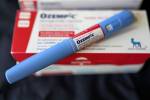Keeping an eye out for AMD
By JOSH MCLEAN
VIEW ON HEALTH
You may not be familiar with age-related macular degeneration now, but with the aging baby boomer generation upon us, AMD is gaining prominence along with a slew of other age-related conditions.
According to the Macular Degeneration Partnership, there are various forms of macular degeneration. However, the fastest growing form of the disease is AMD as the number one cause of vision loss and legal blindness in people over 60 in the U.S.
WHAT IS AGE-RELATED MACULAR DEGENERATION?
Age-related macular degeneration, or AMD, is a disease that affects the central or sharpest vision of the eye. It can also dim sensitivity and perception of color. The first sign is that straight lines start to appear wavy or distorted. In some cases, the disease progresses so slowly that patients hardly notice a change in their vision, while other cases progress quickly and begin to affect both eyes.
Judith Delgado, director of the Macular Degeneration Partnership, said the main thing to realize is that when diagnosed, there are things that can be done. The key thing is early detection and making lifestyle adjustments.
"There are things you can do," Delgado said. "You will always have your peripheral vision. There is help out there to help you use every bit of vision left. You don't have to go home pull the shades down and say 'Oh, well.'"
Everyday activities such as reading, driving, watching TV, identifying people, navigating stairs, doing detailed work, and other tasks are affected by AMD. Delgado stresses training oneself to use the remaining vision to continue living everyday life.
WET AND DRY
There are two forms of AMD, dry and wet.
Wet AMD is the rarer of the two forms. It occurs when abnormal blood vessels begin to develop under the macula. These blood vessels are often fragile and tend to leak blood and fluid. The leakage raises the macula from its normal place on the retina in the back of the eye and causes rapid damage. According to The National Eye Institute, a division of the U.S. National Institutes of Health, wet AMD occurs rapidly and does not progress in stages like dry AMD.
Dry or atrophic AMD develops when light-sensitive cells within the macula begin to slowly break down. Over time, the central vision blurs as less of the macula functions. Central vision is gradually lost in the affected eye in stages. According to Delgado, about 90 percent of those suffering from AMD have the dry form. There is no cure for either form. There are treatments for wet AMD, but none are available for the dry form.
SIGNS AND SYMPTOMS
The most common early sign indicating dry AMD is drusen, which are yellow deposits found under the retina that can be detected during a comprehensive dilated eye exam. The National Eye Institute reports though scientists are unaware of how drusen and AMD are connected, they do know that a person's risk in developing advanced dry AMD or wet AMD is increased by the size or number of drusen a person develops. Delgado stresses the importance of early detection of drusen in treatment of the disease.
"Early detection is absolutely key," Delgado said. "The first part of detection is to get a dilated eye exam every one or two years after the age of 50."
Vision changes can occur in one or both eyes and can be subtle in some cases. The risk of developing the condition increases with age. Some people don't notice a change in vision until it is advanced if AMD only affects one eye.
"This disease usually starts in one eye first, and your eyes work together," Delgado said. "So the good eye can often compensate."
This is especially true of dry AMD, which has three stages. The first stage, early AMD, does have any symptoms other than detection of several small or a few medium drusen. Intermediate AMD, the second stage, results in many medium or large drusen. This stage is when people begin to see a slight blurred spot in the center of their vision and may need more light of detail oriented tasks. The final stage, advanced dry AMD, is when the blurred spot resulting from the breakdown of light sensitive cells gets bigger or darker. All people who develop the wet form of AMD, had the dry form initially, according to the National Eye Institute.
WHO IS AT RISK FOR AMD?
The main risk factor is age, especially people over the age of 60. However, there are lifestyle factor that affect one's risk. Family history, race, obesity and smoking are all risk factors for AMD. In addition, women appear to be at greater risk for the disease than men. Delgado also adds that the conditions seems to affect people with lighter pigments or eyes. "There is just no question that smoking is the worst thing for your eyes," Delgado said. "It can increase your risk two-fold."
She said the lifestyle issues that contribute to AMD are very similar to risk factors for heart disease. A healthy diet rich in fruits and vegetables and low in saturated fats is important in prevention, Delgado said.
The diagnosis of AMD is estimated to rise from the current 10 to 15 million to 21 million by 2010 due to the age wave caused by the baby boomers according to the Macular Degeneration Partnership.
TREATMENT OPTIONS
Wet AMD has several treatment options: laser surgery, photodynamic therapy and eye injections. Though none of these treatments offer a cure, they can delay the progression of the disease.
Laser surgery prevents further loss of vision by destroying the leaking blood vessels that caused the shift in the macula. However, it is possible that the laser will destroy some healthy tissue and vision. In addition, repeated treatments are often necessary because new blood vessels may develop after the initial surgery. Laser surgery is only an option for a small number of people with wet AMD.
Photodynamic therapy also destroys the new blood vessels in the eye that cause AMD, however, this treatment does it without the risk destroying healthy tissue in the process. A drug called verteporfin is injected into a patient's arm and travels to the blood vessels in the eye. Light is shined into the eye for about 90 seconds and activates the verteporfin, which then destroys the blood vessels. Photodynamic therapy does not stop the progression of the disease, and results are often temporary.
Injections that block the effects of the growth factor promoting the development of the abnormal blood vessels causing wet AMD are also an option. These injections must be administered multiple times, sometimes monthly. This treatment can slow the loss of vision and even improve sight in some cases.
Though there is no form of treatment that can prevent vision loss for those with wet AMD, the National Eye Institute's Age-Related Eye Disease Study has found that a specific dose of vitamins can reduce the risk of developing advanced AMD.
Dr. Emily Chew, Deputy Director of the Division of Epidemiology and Clinical Research for the National Eye Institute said they have found that certain high dose vitamins can actually prevent progression and they are continuing research in hopes to find out even more.
"We are hopeful this is going to be helpful in prevention," Dr. Chew said.
The study called for specific amounts of vitamins: 500 milligrams of vitamin C, 400 international Units of vitamin E, 15 milligrams of beta-carotene, 80 milligrams of zinc (zinc oxide) and 2 milligrams of copper (cupric acid).
The levels of vitamins suggested are much higher than a regular multivitamin alone. Dr. Chew said these vitamins can be bought over the counter but still recommends speaking with a physician if you consider starting the AREDS regimen to treat AMD.
"There's a lot of great treatments," Dr. Chew said. "There are some new drugs that can actually improve vision. It's amazing."
If you have been diagnosed with AMD, The Macular Degeneration Partnership, a program of the non-profit Discovery Eye Foundation can provide information and support.Visit their website at www.amd.org.




















